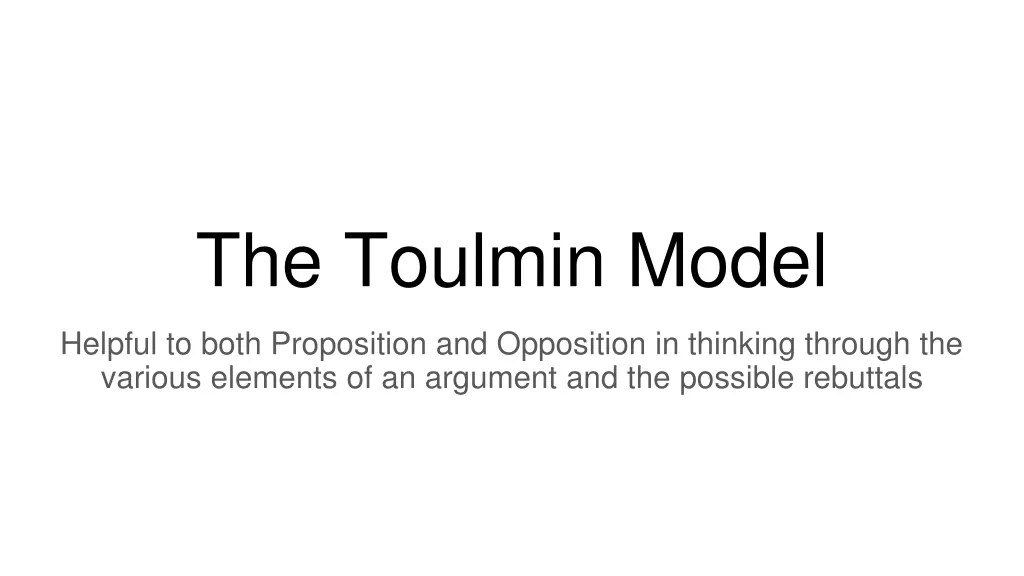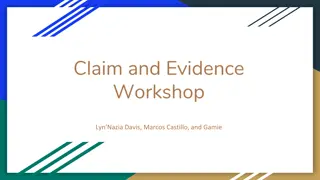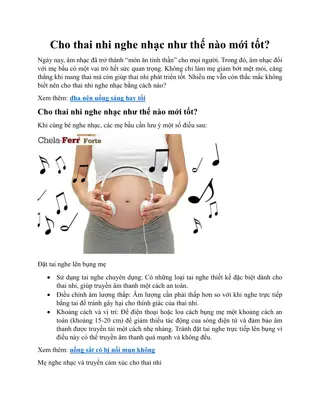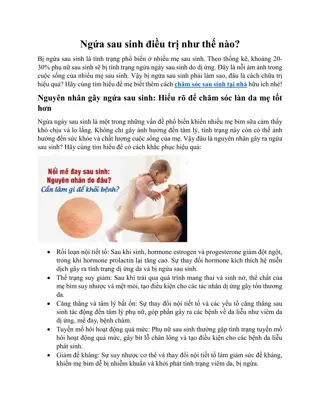
Understanding the Toulmin Model for Effective Argumentation
Explore the Toulmin model, a framework aiding in analyzing and constructing arguments by breaking them down into key components like claim, grounds, warrant, backing, rebuttal, and qualifier. Learn how this model helps strengthen argumentative skills.
Download Presentation

Please find below an Image/Link to download the presentation.
The content on the website is provided AS IS for your information and personal use only. It may not be sold, licensed, or shared on other websites without obtaining consent from the author. If you encounter any issues during the download, it is possible that the publisher has removed the file from their server.
You are allowed to download the files provided on this website for personal or commercial use, subject to the condition that they are used lawfully. All files are the property of their respective owners.
The content on the website is provided AS IS for your information and personal use only. It may not be sold, licensed, or shared on other websites without obtaining consent from the author.
E N D
Presentation Transcript
The Toulmin Model Helpful to both Proposition and Opposition in thinking through the various elements of an argument and the possible rebuttals
The Toulmin model is a framework for analyzing and constructing arguments. It was developed by British philosopher Stephen Toulmin in the 1950s and has since become a widely used tool in many fields, including rhetoric, communication studies, and law. Stephen Toulmin, professor in the Committee on Social Thought, the department of Philosophy, and the Divinity School at the University of Chicago. University of Chicago Photographic Archive, apf7-01437, Hanna Holborn Gray Special Collections Research Center, University of Chicago Library.
The Toulmin model consists of six components: Claim/motion: The main point or thesis that the argument is trying to make. Grounds/premises: The evidence, data, or reasons used to support the claim. Warrant: The underlying assumption or principle that connects the grounds to the claim. Backing: Additional evidence or reasoning that supports the warrant. Rebuttal: Counterarguments or opposing views that challenge the claim. Qualifier: A statement that indicates the degree of certainty or scope of the argument.
By identifying and analyzing these components, the Toulmin model helps people to better understand the strengths and weaknesses of arguments and to construct more effective and persuasive arguments themselves.
An argument constructed after the Toulmin model Claim: We should eat more fruit Grounds: Eating more fruit is beneficial for human health Warrant: Better health is desirable and eating more of it would contribute to an improvement in our health Backing: Scientific studies that show an improvement in those humans health who consume fruit and examples of people who feel better after changing their diets. Rebuttal: There were other factors that were more important, fruit is just one of several factors contributing to better health. Not all people want better health. Some do not like fruit and for them to eat it would be unpleasant and not worth it just for a marginal improvement in their health. Also, those who are allergic would get worse health by eating fruit. Qualifier: Everything else being equal - eating fruit would not balance out other non-beneficial changes, such as taking up smoking or eating sugar to excess.






















